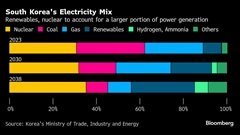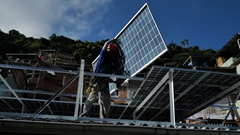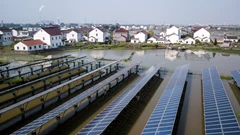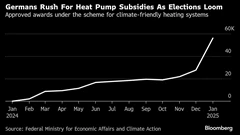Red Tape Holding Up $18 Trillion Needed for 2030 Climate Goals
(Bloomberg) -- Grid constraints, the still high cost of green technology and planning delays are holding up $18 trillion worth of investments needed to reach global 2030 climate goals, making any rapid energy transition increasingly unlikely.
The incorporation of renewable and other low-carbon sources of energy must happen three times faster than previous fuel transitions to limit global warming to 1.5C (34.7F) above preindustrial levels, according to a report from management consulting firm Boston Consulting Group.
“There’s still some blue sky from getting from policy tailwinds to viable business cases,” Maurice Berns, chair of the group’s Center for Energy Impact and one of the report’s co-authors, said in an interview. “We need to get past the top level and into more implementation, the regulations, the disbursements, the actions needed at state level and member state level to get us there.”
Fossil fuel emissions are warming the planet, triggering extreme weather, from flooding in India and the US to wildfires in Greece and Canada. July was the world’s hottest month on record.
Current policies and the speed of the energy transition in sectors such as industrial manufacturing and buildings would permit warming to 2.7C by 2100, which is “woefully insufficient.”
The main shortfall in funding was in the electricity and end-user categories, where the gap was primarily of investments in renewable power, the report said.
“For renewables, the higher cost of finance negatively impacts the cost of renewable energy produced, increasing the competitiveness of fossil investments,” it added.
Several studies have assessed the investment requirements and gaps in the world’s energy transition targets. According to BloombergNEF, global annual investment needs to triple throughout this decade in order to achieve a net zero emissions world by 2050. Current levels of capital spending are not aligned with that goal, the BNEF report shows.
However, the world already has the tools and capital needed to effect the changes, the BCG report said. Out of the $37 trillion needed by 2030, roughly $19 trillion has already been committed, the consulting firm calculated by using a bottom up build methodology across 270 energy companies.
Governments and the private sector need to need work together on finding a way to bring down the cost of deploying low carbon technologies and make the business cases viable to bridge the $18 trillion gap. That’s where policies like the US Inflation Reduction Act can help, according to the report.
In the UK alone, it’s estimated that there’s about 220 gigawatts capacity — about two-thirds in wind and the rest in solar — in the connection queue, while in Spain there’s about 180 gigawatts in the queue, which is also similar across systems and countries around the world, Berns said.
“It’s not a technical challenge because we know what technologies we need to put into place and they exist,” he added. “It’s a matter of getting a bit of acceleration into the system, to see things progress.”
©2023 Bloomberg L.P.
KEEPING THE ENERGY INDUSTRY CONNECTED
Subscribe to our newsletter and get the best of Energy Connects directly to your inbox each week.
By subscribing, you agree to the processing of your personal data by dmg events as described in the Privacy Policy.
More renewables news

GB Energy Faces New Doubts as UK Declines to Affirm Future Funds

Korea Cancels Planned Reactor After Impeaching Pro-Nuke Leader

Brazil’s Net-Zero Transition Will Cost $6 Trillion by 2050, BNEF Says

SolarEdge Climbs 40% as Revenue Beat Prompts Short Covering

EU to Set Aside Funds to Protect Undersea Cables from Sabotage

China Revamps Power Market Rules In Challenge to Renewables Boom

KKR increases stake in Enilive with additional €587.5 million investment

TotalEnergies and Air Liquide partner to develop green hydrogen projects in the Netherlands

Germany Set to Scale Down Climate Ambitions
















